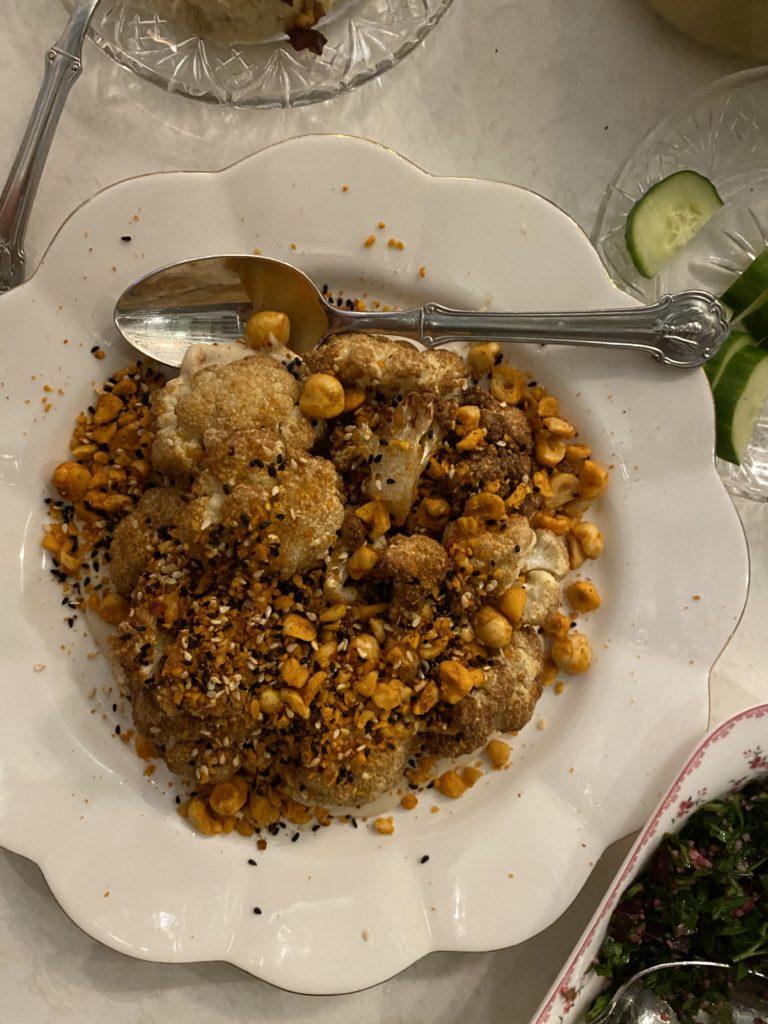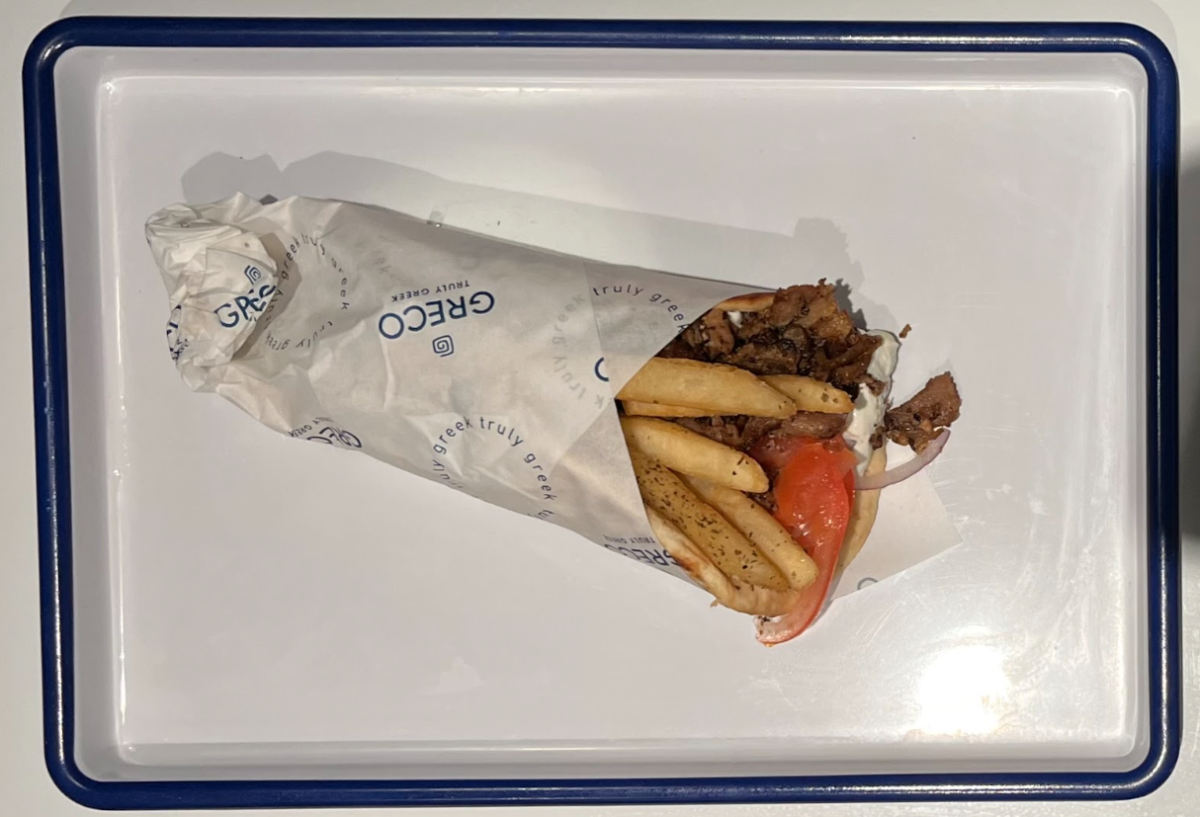Villa Yara, a blissful combination of Lebanese fable and food that sits happily at the foot of Georgetown, the restaurant and garden is the ideal spot for a tasty sampling of mezze this summer.
Found on a quiet strip of M Street before the bustle of commercial shops, the recently opened Villa Yara is serving up Lebanese-inspired shareable plates from within a restored Georgetown home. The restaurant’s name honors Yara, a fable character from the song of famous Lebanese singer Fairouz, and this inspiration cultivates a feminine and fairy-like feel throughout the restaurant as a whole, with an upstairs mural depicting the restaurant’s namesake.
Upon entrance to the restaurant, patrons are met with a bar and small seating area to the right, and a staircase leading to an upstairs dining room to the left. A narrow corridor leads past the bar into a spacious main dining room adorned with geometric wooden floors, exposed brick walls and framed photos of Lebanon during the 1970’s and 80’s. French doors open up from the dining room to the most magical part of Villa Yara: the outdoor patio. Modeled after traditional Lebanese villas, the patio has a central fountain, hanging fairy lights and plants, tiled floors and colorful furniture.
My friend and I arrived just after 7 p.m. on a Sunday night and we were promptly led upstairs, where we were met with velvet evergreen booths, light fixtures made of ’70s era hats and overhead lights draped in dangling threads like a 1920’s flapper skirt. We tucked ourselves into a corner booth, facing the floor to ceiling mural of the blond-haired, blue-eyed Yara.
Soft music plays aloud, but not loud enough to mask the colorful sounds of laughter, the clinking of glasses amid “cheers” and the scraping of every last morsel of food from plates. We started with sipping on herbal, fruity drinks served in etched clear glasses while we conversed with our waiter about his favorite menu offerings.
Everything at Villa Yara is meant to be shared family style, with menu offerings from the cold mezze, warm mezze, oven-baked and charcoal-grilled sections. The cold mezze section lists classic dips like hummus ($12), baba ghanoush ($13) and mouhamara ($13), while the warm mezze section has potato, lamb and beef dishes. The oven-baked section offers rice and savory pie creations, while the charcoal-grilled section provides a variety of grilled meat and fish meals.
After indulging on the complimentary pita bread and subtly spicy olive tapenade, we followed our waiter’s suggestions and ordered the baba ghanoush ($13), the spinach fatayer ($12), the Yara’s tabbouleh ($16) and the arnabeet ($14). The spinach fatayer was a crispy puff pastry filled with a savory and earthy spinach purée, topped with sesame seeds and served in a martini glass — sweet notes of onion and sumac emerged from each decadent bite.
The Yara’s tabbouleh was a twist on the classic dish, using beet and pomegranate in place of tomato, elevating a typically earthy dish. The tabbouleh had a symphony of flavors, from the sweet mint to the tart pomegranate and sour lemon, sharp beet and savory bulger all mixed in with herbal parsley. The baba ganhoush, which we spread thickly over fresh cucumber and fluffy pita bread, was a buttery and nutty dip that melted on our tongs. Juicy pomegranate seeds added a buzz of sweet and tart juice to the otherwise savory dish.
The star of the show was the arnabeet, a fried cauliflower dish topped with spiced hazelnuts and served on a bed of tahini taratoor, a creamy, citrusy sauce. Atop the pieces of lightly fried cauliflower were an array of spices that mirrored the composition of an everything bagel, with poppy and sesame seeds, garlic and onion. Full and crushed hazelnuts, dusted in a spice mixture that gave them an orange coloring, adorned the dish.
The cauliflower was fried to form a crispy cast on the outside but maintained a buttery texture within and had none of the excess grease associated with fried dishes. The textural contrast of the two nutty elements — the tahini spread and the hazelnuts — complemented the soft inside of the cauliflower. The spices on top fully tied the dish together.
We saved just enough room in our stomachs for our waiter’s favorite dessert, the Yara’s Dream ($12). A simply poetic combination of thick sweet cream sandwiched between a pistachio and spirulina crepe, topped with ashta ice cream and chopped pistachios.
After devouring the subtly sweet and nutty dessert, our waiter then led us on a tour of the restaurant, showing us the private room and patio for parties, the downstairs kitchen, ending in the outdoor garden as the sun set and small fireflies graced patrons with their presence. The fairytale-like patio transported me back to my childhood of sipping iced tea in my grandfather’s garden as a summer day slipped away.
Villa Yara creates a cozy environment where time seems to pause, allowing for lively conversations as plates piled full of Lebanese treasures are passed around the table. The restaurants’ light, flavorful and summery creations only add to the homey atmosphere, making the spot the ideal choice for a summer dinner.
As we walked out into the summer night, bellies full and hearts happy, we could not help but plan our next visit to the establishment, giddy at the possibility of trying more of their Lebanese bites.






